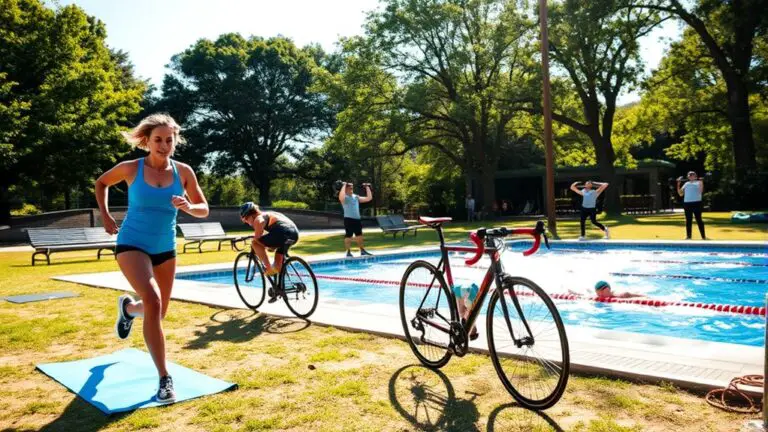How to Train for Endurance Sports During the Off-Season

To train for endurance sports during the off-season, evaluate your fitness to identify strengths and weaknesses, and set specific, measurable goals. Incorporate cross-training activities like cycling and swimming to enhance strength and flexibility. Prioritize recovery with active techniques and focus on injury prevention through proper stretching and moderate weights. Keep your routines fresh and exciting to maintain motivation, ensuring your training aligns with your goals. Discover more strategies to optimize your off-season preparation.
Understanding the Importance of the Off-Season

While many athletes view the off-season as a time for rest and relaxation, it’s actually a vital period for enhancing performance in endurance sports. You might not realize it, but the off-season offers significant benefits that can improve your overall capabilities. It’s the perfect time for a mental reset, allowing you to reflect on your previous season’s performance and set new goals.
Taking a break from the rigorous demands of training helps prevent burnout and reduces the risk of injury. By focusing on recovery and cross-training, you can develop strength and flexibility, which are essential for endurance. This allows you to return to your sport refreshed and ready to tackle new challenges. Embracing the off-season can lead to improved physical and mental resilience, ultimately setting the stage for a successful upcoming season. Don’t underestimate this time; it’s important for your growth as an athlete.
Structuring Your Off-Season Training Plan
To structure an effective off-season training plan, you need to start by evaluating your current fitness levels. Once you have a clear understanding of where you stand, set specific goals that will guide your progress and keep you motivated. Finally, incorporating cross-training activities can enhance your overall performance and prevent burnout.
Assess Current Fitness Levels
Evaluating your current fitness levels is vital for designing an effective off-season training plan. Conducting a fitness evaluation helps identify your strengths and weaknesses, providing a clear baseline for improvement. Start with a thorough review of your performance benchmarks, such as endurance capacity, speed, and recovery rates. Use time trials or maximum effort tests to gather quantifiable data. This information will inform your training intensity, volume, and specific areas for focus. Remember, knowing where you stand allows you to tailor your workouts, ensuring you’re not overtraining or undertraining. By objectively evaluating your fitness, you set the stage for progress, making your off-season training both purposeful and effective. Embrace this step; it’s vital for long-term success in endurance sports.
Set Specific Goals
Setting specific goals is essential for structuring your off-season training plan, as it provides direction and purpose to your efforts. Use goal setting strategies that align with your long-term aspirations while breaking them down into manageable, measurable objectives. Consider performance metrics like endurance levels, speed, and recovery times to tailor your goals effectively. For instance, aim to increase your mileage by 10% weekly or improve your 5K time by a specific amount. Tracking these metrics will not only give you tangible benchmarks to aim for but also keep you motivated throughout the off-season. Remember, clarity in your goals fosters commitment and discipline, ensuring you’re well-prepared for the upcoming season and enhancing your overall performance.
Incorporate Cross-Training Activities
While you focus on building endurance, incorporating cross-training activities into your off-season training plan can greatly enhance your overall performance. Engaging in cycling drills, for instance, not only improves leg strength but also increases your cardiovascular capacity, making your primary sport feel easier. Meanwhile, refining swimming techniques can enhance your breathing efficiency and core stability, essential for long-distance events. By alternating between these activities, you’ll reduce the risk of overuse injuries while promoting muscle recovery through varied movements. Additionally, cross-training can keep your training fresh and exciting, maintaining motivation. Remember, the aim is to create a balanced regimen that supports your endurance goals while developing strength, flexibility, and coordination. Embrace the diversity—your body will thank you.
Incorporating Cross-Training Activities
Incorporating cross-training activities into your endurance training regimen can considerably enhance your performance and reduce the risk of injury. By integrating cycling drills and swimming intervals, you diversify your workout routine, targeting different muscle groups while improving cardiovascular fitness. Cycling drills, for instance, can help build leg strength and stamina without the impact stress of running. On the other hand, swimming intervals offer a low-impact alternative that boosts aerobic capacity and enhances recovery through active engagement of the upper body.
Additionally, these activities can break the monotony of traditional training, keeping you mentally engaged and motivated. Aim to include at least two cross-training sessions weekly, focusing on intensity and duration to match your specific endurance goals. By strategically incorporating these cross-training methods, you’ll develop a well-rounded fitness base, enabling you to tackle upcoming races with renewed vigor and resilience. Stay dedicated, and watch your performance soar!
Prioritizing Recovery and Injury Prevention

To maximize your endurance training, prioritizing recovery and injury prevention is essential. Incorporating active recovery techniques, safely strengthening muscles, and focusing on flexibility and mobility work can enhance your performance and longevity in the sport. By taking these steps, you’ll not only improve your resilience but also set yourself up for sustained success.
Active Recovery Techniques
Active recovery techniques play an essential role in enhancing your endurance training regimen, as they focus on promoting recovery and preventing injuries. Incorporating these methods helps you maintain your fitness while allowing your body to heal. Here are three effective techniques:
- Foam Rolling: This helps release muscle tension and improve circulation, reducing soreness after intense workouts.
- Active Stretching: Engaging in dynamic stretches keeps your muscles flexible and ready for your next session, preventing stiffness.
- Mindfulness Techniques: Incorporate breathing exercises and yoga sessions to enhance your mental focus and reduce stress, facilitating recovery.
Strengthening Muscles Safely
While building strength is essential for endurance athletes, it’s important to prioritize recovery and injury prevention throughout the process. Incorporating muscle conditioning into your routine enhances performance, but you must do it safely. Start with moderate weights and gradually increase resistance, focusing on form over quantity. This approach helps prevent strains and allows your muscles to adapt effectively. Implement rest days to allow your body to recover; overtraining can lead to setbacks. Don’t forget to listen to your body—if something feels off, it likely is. Incorporating cross-training can also aid in safe strengthening, providing variety while reducing injury risk. By balancing strength training with adequate recovery, you’ll build a resilient foundation for endurance sports success.
Flexibility and Mobility Work
Incorporating flexibility and mobility work into your training regimen is essential for preventing injuries and enhancing overall performance. It’s not just about pushing your limits; it’s about ensuring your body can handle the demands of endurance sports. Here are three critical practices to include:
- Dynamic Stretching: Prior to workouts, engage in dynamic stretching to warm up your muscles and improve range of motion.
- Foam Rolling: Post-training, use foam rolling to release muscle tightness and improve blood flow, aiding recovery.
- Static Stretching: Incorporate static stretching after workouts to maintain flexibility and facilitate muscle recovery.
Setting Goals for the Upcoming Season

As you prepare for the upcoming season, establishing clear and achievable goals is essential for your success in endurance sports. Start by utilizing goal visualization techniques, where you mentally picture your desired outcomes, whether it’s completing a race or hitting a specific time. This practice not only boosts motivation but also enhances focus during training sessions.
Next, define your performance benchmarks. These metrics will help you assess your progress and stay accountable. Identify key areas for improvement, such as pacing, endurance, or recovery, and set measurable targets for each. For instance, aim to reduce your 5K time by a certain percentage or increase your long-run distance gradually.
Staying Motivated During the Off-Season
Even though the off-season can feel like a lull in your training, it’s essential to maintain motivation to guarantee a strong return when the season kicks off again. Off-season challenges can sap your drive, but adopting effective motivational strategies can keep you focused.
Here are three ways to boost your motivation during the off-season:
- Set Short-Term Goals: Instead of only focusing on the upcoming season, create measurable goals for the off-season. This can help track progress, making training feel more rewarding.
- Mix Up Your Routine: Try new activities or cross-train. Engaging in different sports can keep your training fresh and exciting.
- Find a Training Partner: Teaming up with someone can provide accountability and make workouts more enjoyable, helping you stay committed.
Frequently Asked Questions
How Does Nutrition Impact Off-Season Endurance Training?
Nutrition’s essential in off-season endurance training. By focusing on nutrient timing, you can maximize recovery and muscle adaptation. Consuming the right nutrients post-workout guarantees your body repairs effectively. Additionally, implementing hydration strategies is critical; staying adequately hydrated enhances performance and aids recovery. Don’t underestimate the power of proper nutrition. It’s not just about fueling your body, but optimizing it for when you hit the ground running again. Stay committed!
Should I Completely Stop Training During the Off-Season?
You shouldn’t completely stop training during the off-season. Instead, consider incorporating cross training benefits to maintain your fitness. Engaging in different activities can improve overall strength and prevent burnout. Active recovery is essential too; it helps your body heal while keeping you engaged. By staying active, you’ll enhance your endurance and prepare your body for the next season. Balance rest with moderate training for best results and to maintain your competitive edge.
How Can I Measure My Off-Season Progress?
You might think measuring off-season progress isn’t necessary, but it’s essential for maintaining motivation. Start with fitness assessments like timed runs or endurance tests to establish benchmarks. Regular progress tracking, such as weekly workouts and heart rate monitoring, helps you see improvements over time. Consider using a training log or app to visualize your gains. This analytical approach not only keeps you accountable but also fuels your drive to stay committed during the off-season.
What Should I Do if I Feel Unmotivated?
If you’re feeling unmotivated, it’s essential to reassess your goal setting. Break your larger objectives into smaller, achievable milestones. This can reignite your passion and give you a clearer path forward. Implement mental strategies, like visualization or positive affirmations, to boost your confidence and focus. Remember, motivation ebbs and flows, but by establishing a structured plan and incorporating these techniques, you’ll likely find your drive returning sooner than you expect.
How Can I Prevent Weight Gain During the Off-Season?
Preventing weight gain during the off-season can be a challenging chore, but with a clever combination of cross training options and healthy snacks, you can conquer it! Consider cycling, swimming, or yoga to keep your metabolism moving. Pair those activities with nutritious snacks like fruits, nuts, or yogurt to maintain energy levels without overindulging. Staying consistent will not only help you avoid weight gain but also keep you primed for the upcoming season.





